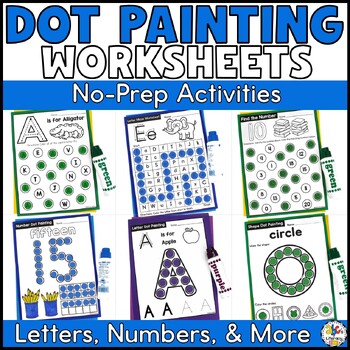Dot Marker Printables - BINGO Dot Painting Worksheets - Fine Motor Activities
- Zip
What educators are saying
Products in this Bundle (7)
showing 1-5 of 7 products
Description
Use this bundle of no-prep Dot Painting Worksheets help your preschoolers and kindergarteners practice letter recognition, number identification, shape formation, and so much more!
When using bingo daubers or dot markers, your kids will also work on developing their fine motor skills too!
***Save 20% by buying the bundle!***
What's Included:
- Letter Dot Painting Worksheets
- Number Dot Painting Worksheets
- Shape Dot Painting Worksheets
- Find the Letter Dot Painting Worksheets
- Find the Number Dot Painting Worksheets
- Capital and Lowercase Letter Mazes
- Beginning Sounds Worksheets
This is an endless bundle which means all dot painting activities (non-holiday or seasonal) that I create in the future will be added to this bundle, and you’ll be able to download them for FREE!
Click on the PREVIEW button above to get a closer look at this activity.
Why Teachers Love This Bundle:
⭐️⭐️⭐️⭐️⭐️ "We use these dot pages in our Pre-K and early childhood classes with 3-5 year olds. They love the pages and are very engaged using them." - Taylor
⭐️⭐️⭐️⭐️⭐️ "My students love every activity with the dobbers!! I love how engaged they are with their learning and practicing letters and sounds. I would definitely recommend this bundle!" - Mary
⭐️⭐️⭐️⭐️⭐️ "Great resources. I have been using them for center time. I put in plastic sleeves and students use mini erasers to locate the letters and numbers." - Despina
You May Also Like:
☑ Beginning Sounds Activities Bundle
Information For You:
Each time you give feedback, TpT gives you feedback credits that you use to lower the cost of your future purchases.
Follow me and be notified when new products are uploaded. New products are 50% off for the first 24 hours they are posted.
If you have any questions, please feel free to email me or use the Ask a Question feature.
Thank you!





